________________________________________
PHOTO OF THE WEEK
 The Suffolk County Historical Society’s Photo of the Week is created by our librarian, Wendy Polhemus-Annibell, using historic materials from our local history library’s extensive and varied archives. SCHS Photo of the Week is available by subscription only. Please email wannibell@schs-museum.org to subscribe.
The Suffolk County Historical Society’s Photo of the Week is created by our librarian, Wendy Polhemus-Annibell, using historic materials from our local history library’s extensive and varied archives. SCHS Photo of the Week is available by subscription only. Please email wannibell@schs-museum.org to subscribe.
MEMBERSHIP
We invite you to join the Suffolk County Historical Society, founded in 1886. Our museum exhibits, educational programs, and local history archives reflect and document Suffolk County’s rich history. http://www.suffolkcountyhistoricalsociety.org/membership.html
—————————————————————————————————–
PHOTO OF THE WEEK: Dec. 25, 2014 — FROM THE SCHS LIBRARY ARCHIVES
Early 20th-Century Christmas Postcards
 Early 20th-Century Christmas Postcards. Image collage created from materials in the Holiday Postcard Collection of the Suffolk County Historical Society, © Suffolk County Historical Society. All rights reserved.
Early 20th-Century Christmas Postcards. Image collage created from materials in the Holiday Postcard Collection of the Suffolk County Historical Society, © Suffolk County Historical Society. All rights reserved.
Back in the early decades of the twentieth century when it cost a penny for a stamp, postcards were a popular way to share holiday greetings with friends and family.
Happy Holidays from the Suffolk County Historical Society to all our friends and supporters!
—————————————————————————-
SCHS Photo of the Week: Click Here to Visit Webpage
Visit: www.suffolkcountyhistoricalsociety.org
___________________________________________________________________
PHOTO OF THE WEEK: Dec. 19, 2014. FROM THE SCHS LIBRARY ARCHIVES
Temple Mishcan Israel, Sag Harbor, c. 1900
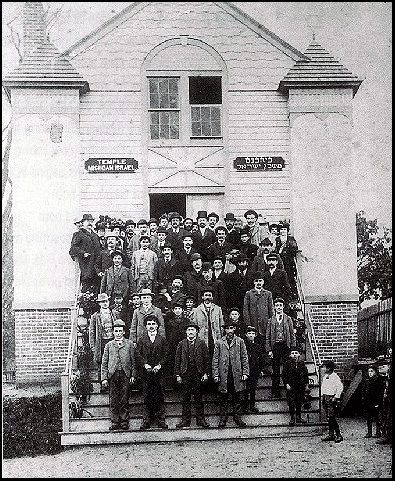
Temple Mishcan Israel, Sag Harbor, c. 1900: First Synagogue on Long Island. Image courtesy Eileen Moskowitz, Temple Adas Israel.
As Long Island’s oldest synagogue, Temple Adas Israel was founded as Congregation Mishkan Israel in 1893. The temple purchased land in 1896, and the building was completed in c. 1900. The Brooklyn Daily Eagle attributed the creation of the new congregation to the establishment of Fahy’s watchcase factory, which had drawn a large number of Russian and Polish-Jewish workers to Sag Harbor. Formal dedication ceremonies were held October 28, 1900.
The exterior of the temple was painted white; it had a peaked roof and two plain white pillars that stood on either side of the entrance door. Inside, in European tradition, there were two altars: one in the center of the synagogue where the rabbi and cantor read the Torah scroll, and the other at the East wall facing Jerusalem, containing the Ark, Eternal Light, and Tablets of the Commandments. Seating capacity was 100. Since the temple was originally Orthodox––and women were not permitted to worship with men––a Ladies Gallery, with its own exterior entrance, was built with additional seating for 60. The basement contained a mikvah, a baptismal font used by Orthodox Jewish women for purposes of ritual cleanliness, as well as in the ceremony of conversion of a Gentile to Judaism. There was also an apartment for a janitor, which was later used by resident and itinerant rabbis.
Legend has it that Sag Harbor’s Temple Mishcan Israel was given its first Torah by Theodore Roosevelt. According to the story, Roosevelt acquired the Torah in 1898 when he returned to the United States with twelve hundred Rough Riders he had led in the charge up San Juan Hill during the Spanish American War. When three of his men contracted yellow fever, Roosevelt returned to American shores via Montauk. The brigade was quarantined for a month to ensure no one else caught the contagious disease. During their stay in Montauk the men held worship services, including Shabbat services for the Jewish soldiers. A Torah was procured for this purpose. When the brigade left, after the quarantine period, Roosevelt donated the Torah to the nearest synagogue: Temple Mishcan Israel in Sag Harbor.
INFO. SOURCE: Beth Moskowitz, “Temple Adas Israel, Sag Harbor, NY: Our History.”
————————————————————-
Visit: www.suffolkcountyhistoricalsociety.org
_________________________________________________
PHOTO OF THE WEEK: Dec. 12, 2014 FROM THE SCHS LIBRARY ARCHIVES
Oyster Bay Cove, 1900, by Hal B. Fullerton
To view this photo, please visit the Suffolk County Historical Society’s website, link at bottom of this week’s photo entry — Oyster Bay Cove at Low Tide with Stranded Schooners, 1900, by Hal B. Fullerton. Image from the Harry T. Tuthill Fullerton Collection of the Suffolk County Historical Society [149.7.129]. Copyright © Suffolk County Historical Society. All rights reserved.
“On June 4th I anchored in a commodious haven on the north of Long Island. We found fine oysters there, from which the Dutch call it Oyster Bay.” – Diary of the Patroon De Vries, 1639
“There could be no healthier and pleasanter place in which to bring up children than that nook of old-time America around Sagamore Hill.” – Autobiography of Theodore Roosevelt, 1913
Oyster Bay was settled by the Dutch and was the boundary between the Dutch New Amsterdam colony and the English New England colonies. The English, under Peter Wright, first settled in the area in 1653. The boundary between the Dutch and the English in Oyster Bay was somewhat fluid, which led to each group having its own Main Street.
In his report of New Netherland in 1650 to the Dutch West India Company, Secretary van Tienhoven waxes enthusiastic, describing Long Island as a “crown of the Province by reason of its…excellent bays and harbors as well as convenient and fertile lands.” He continued: “Long Island … is the levelest and finest soil in New Netherland; very well adapted for agriculture and the rearing of all sorts of cattle; furnished with beautiful valleys, navigable harbors, rivers, and bays, the chief of which are Hempstead Bay, Martin Gerritsen’s Bay, and Oyster Bay.”
INFO. SOURCE: Frances Irvin, Oyster Bay in History (undated).
————————————————————-
Visit: www.suffolkcountyhistoricalsociety.org
_________________________________________________
PHOTO OF THE WEEK: Dec. 5, 2014: FROM THE SCHS LIBRARY ARCHIVES
Babylon Fire Race
To view this photo, please visit the Suffolk County Historical Society’s website, link at bottom of this week’s photo entry — Babylon: Fire Tournament and Race, c. 1899, by Hal B. Fullerton. Image from the Harry T. Tuthill Fullerton Collection of the Suffolk County Historical Society. Copyright © Suffolk County Historical Society. All rights reserved.
——————————————-
Babylon Town, originally a part of Huntington Town, was known as South Huntington (or Huntington South). The earliest inhabitants of the town were the Massapequa and Secatogue tribes. The first purchase of land from the Native Americans in what is now the Town of Babylon was made in 1657 by Jonas Wood. Early English settlers set up the Town Meeting form of government, and the first recorded Town Meeting took place on March 10, 1659.
For many years, the southern part of Huntington Town held little attraction for permanent settlement. However, along the bay and on its islands much salt hay grew, which was needed to balance the diet of the cattle on North Shore farms. To harvest and bring back salt hay from the South Shore, the early settlers used Native American trails to drive their ox carts over from the North Shore. The two main routes, which crossed the East-West “Indian Path,” followed today’s Deer Park Avenue and Route 110.
The earliest written evidence of the town’s present name is found in an inscription from the chimney of the Nat Conklin House:
New Babylon This House Built by Nat Conklin 1803
INFO. SOURCE: Robert Mills Smith (Babylon Town Historian), “A Brief History of the Town of Babylon,” 1979.
————————————————————- SCHS Photo of the Week: Click Here To View Original Photo of the Week — November 21, 2014 — Web Page.
Visit: www.suffolkcountyhistoricalsociety.org
_________________________________________________
PHOTO OF THE WEEK: Nov. 27, 2014: FROM THE SCHS LIBRARY ARCHIVES
Happy Thanksgiving from the Suffolk County Historical Society!
Thanksgiving Postcards, Early 1900s
 Early 20th-Century Thanksgiving Postcards, 1908-1926. Image collage created from materials in the Holiday Postcard Collection of the Suffolk County Historical Society, © Suffolk County Historical Society. All rights reserved.
Early 20th-Century Thanksgiving Postcards, 1908-1926. Image collage created from materials in the Holiday Postcard Collection of the Suffolk County Historical Society, © Suffolk County Historical Society. All rights reserved.
Back in the early decades of the twentieth century when it cost a penny for a stamp, postcards were a popular way to share holiday greetings with friends and family. Here are a few excerpts from the postcard writers:
D.K. to Grace Miller of “Millers Place”: We are having a beautiful trip. The ocean has been as smooth as the Sound. It begins to feel like Florida. We have 165 passengers all told. Postmarked: Charleston, SC, 1910.
D. Tarbox to Ruth Verity of Greenport: Dear Ruth, I recieved your letter the other day. We are all well. Your grandmother wrote to us. I hope you will like this card. I wish you a happy Thanksgiving. Postmarked: Rhode Island, 1916.
Gertrude Travers to G. Miller of Miller’s Place: Suppose you think I have forgotten that it is my turn to write. I haven’t, and I will do it soon. Postmarked: Brooklyn, 1926.
John (or Jane?) to Kate Edwards of Patchogue (forwarded from Sag Harbor): Dear Kittie, I don’t see no letters coming my way from Sag Harbor. How are you? I have been in bed this last week with a cold but am much better now. Hope you are well. Mama and [illegible] came for a visit from Long Island and stayed over Sunday. Why can’t you come visit? Are you mad at me! Postmarked: New Haven, Nov. 28, 1908; then Sag Harbor, Dec. 5, 1908 and re-addressed to Patchogue., L.I.
Cousin Sara to Miss Miller of Miller’s Place: Hope you are all home enjoying Thanksgiving. Thanks for the cards. We have been taking pictures with Betty’s little camera and will send some later. Postmarked Ivoryton, CT, 1909.
Thanksgiving Menu & Toast (1916)
Green Tea Turtle Soup Baked Blue Fish Turkey with Oysters, Peas, Beets, Carrots, and Potatoes Apples, Pumpkin Pie, Ginger Cake Cider, Water, Milk, Coffee
May all of the dishes Come up to your wishes!
————————————————————- SCHS Photo of the Week: Click Here To View Original Photo of the Week — November 21, 2014 — Web Page. Visit: www.suffolkcountyhistoricalsociety.org
_________________________________________________
PHOTO OF THE WEEK: Nov. 21, 2014: FROM THE SCHS LIBRARY ARCHIVES
November is New York State History Month!
If you’ve been enjoying our Photo of the Week series, please consider becoming a member of the Suffolk County Historical Society. Visit our website or call 727-2881 for details.
——————————————————————-
Port Jefferson Boat Storehouse, by Hal B. Fullerton, 1897
To view Hal B. Fullerton photograph visit the Suffolk County Historical Society website. The village of Port Jefferson, originally called Drowned Meadow because the tidal area was “drowned” by the tide twice daily, was among the largest shipbuilding centers in Suffolk County in the nineteenth century. With the natural superiority of its protected harbor, the village also engaged in some of the earliest shipbuilding in the entire country. By 1840, shipyards and marine railways were to be found in almost every village located along the shores of Long Island. By 1855, some twenty-five shipyards were in operation in the county. Men of all ages toiled in seafaring professions–nearly a third of the male population in Suffolk County was so engaged by 1885. More than 800 boats had been built in Suffolk County by that time, and 327 of those vessels were constructed in Port Jefferson. INFO. SOURCE: Gordon Welles and William Proios, Port Jefferson: Story of a Village (Port Jefferson, NY: Port Jefferson Historical Society, 1977).
_____________________
“Hal B. Fullerton: Crisp Images from a Faded Long Island Past” The New York Times | May 3, 2013
“Mr. Fullerton was a great documenter of Long Island, but he was also a great photographer.” —Neil Scholl, Professor Emeritus, New York Institute of Technology
“Anyone interested in exploring the visual landscape of Long Island’s past will find the photographs of Hal B. Fullerton…immensely valuable. Fullerton’s work was so extensive, inclusive, and pervasive that it is difficult to imagine the Island’s appearance at the turn of the twentieth century without conjuring up his pictures.” —Charles L. Sachs, The Blessed Isle
————————————————————-
SCHS Photo of the Week: Click Here To View Original Photo of the Week — November 21, 2014 — Web Page. Visit: www.suffolkcountyhistoricalsociety.org _______________________________________________________
PHOTO OF THE WEEK: Nov. 14, 2014: FROM THE SCHS LIBRARY ARCHIVES
Helen Keller Lecture at Riverhead High School, 1933
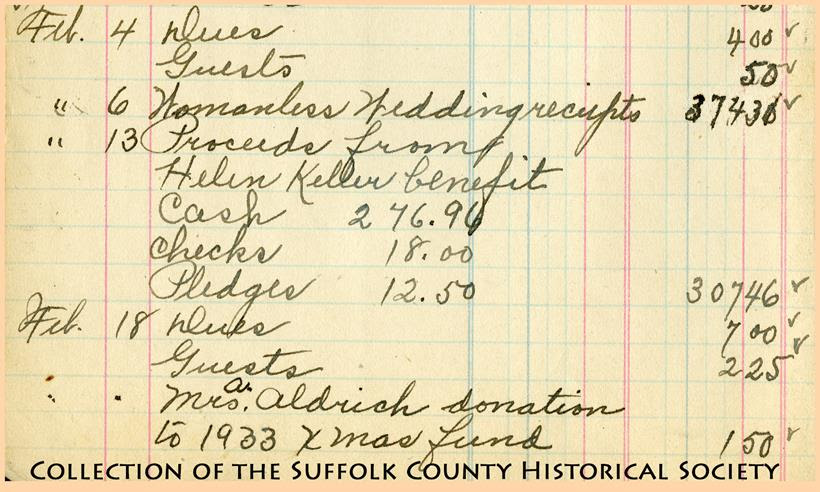 Helen Keller Lecture at Riverhead High School, 1933. Riverhead Woman’s Club Treasurer’s Account Book page for Feb. 13, 1933: “Proceeds from Helen Keller Benefit…$307.46.” From the Collection of the Suffolk County Historical Society Library Archives [188.39]. In February 1933, due to the good work of the Woman’s Club of Riverhead, the people were privileged to see and hear Hellen Keller, the famous blind and deaf woman, in the Riverhead High School Auditorium. Miss Keller came to deliver some of her inspirational lectures. No admission was charged, but contributions were accepted. Mrs. George E. Pugsley, president of the Woman’s Club, noted in the Treasurer’s Account Book that $307.46 was collected in cash, checks, and pledges. In addition to Miss Keller’s address, the program featured violin solos by Miss Bessie Wells and vocal selections by Alton Medager, baratone. ———————————————————————–
Helen Keller Lecture at Riverhead High School, 1933. Riverhead Woman’s Club Treasurer’s Account Book page for Feb. 13, 1933: “Proceeds from Helen Keller Benefit…$307.46.” From the Collection of the Suffolk County Historical Society Library Archives [188.39]. In February 1933, due to the good work of the Woman’s Club of Riverhead, the people were privileged to see and hear Hellen Keller, the famous blind and deaf woman, in the Riverhead High School Auditorium. Miss Keller came to deliver some of her inspirational lectures. No admission was charged, but contributions were accepted. Mrs. George E. Pugsley, president of the Woman’s Club, noted in the Treasurer’s Account Book that $307.46 was collected in cash, checks, and pledges. In addition to Miss Keller’s address, the program featured violin solos by Miss Bessie Wells and vocal selections by Alton Medager, baratone. ———————————————————————– 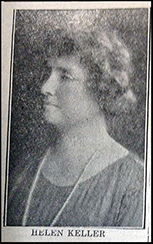 “It is said of Miss Keller that she is a brilliant example of what may be accomplished in spite of physical handicaps–she has demonstrated how even physical infirmities add no barrier to a life of happiness and accomplishment” (The Riverhead News, February 10, 1933). —————————————————-
“It is said of Miss Keller that she is a brilliant example of what may be accomplished in spite of physical handicaps–she has demonstrated how even physical infirmities add no barrier to a life of happiness and accomplishment” (The Riverhead News, February 10, 1933). —————————————————-
 Riverhead High School, 1909. Image from the Riverhead Pictorial Collection of the Suffolk County Historical Society Library Archives [197.12.64].
Riverhead High School, 1909. Image from the Riverhead Pictorial Collection of the Suffolk County Historical Society Library Archives [197.12.64].
————————————————-
SOME PAST PHOTOS OF THE WEEK
Medford Boy Scout Troop, 1917 Elisha Wells Civil War Portrait, 1864 The East Moriches Eagle, 1923 SCHS Labor Day Float, Riverhead, 1928 Donaldson’s General Store, Hauppauge, 1906 LIRR Experimental Farm Exhibit at Brooklyn YMCA, 1910 Edward Thompson Fishing from Daniel Webster’s Bridge, Smithtown, May 1903 Judge Griffing, Grangebel Park, Riverhead, 1908 Montauk Lighthouse & Wainscott Mill, c. 1922 Mattituck High School Class of 1918 Avery’s Beach, Blue Point, 1912 Manor of St. George Patent, 1697 Capt. Henry Green, 1824 Walt Whitman, 1819-1892 Camp Dunes: Lake-by-the-Sea, Peconic, c. 1920s Central Islip School, c. 1898 Lady Suffolk, the Old Gray Mare from Commack Oyster Sloops at New Suffolk, c. 1900 The Gates to Sagtikos Manor, West Bay Shore, 1950s Vanderbilt Cup Race, Jericho, 1904 Memorial Day, Riverhead, 1920 Long Dock, Patchogue, 1898 Sag Harbor Toll House, 1800s Tuthill House, Jamesport, 1880s LIRR Train to Wading River, 1906 Greenport Group Portrait, 1890s Riverhead Fire Dept. Brass Band, 1910 Riverhead Woman’s Club Spring Luncheon, 1933 L.I. Women’s History: Edith Loring Fullerton (1876-1931) Long Island Suffrage Wagon, c. 1913 Local Suffragists, 1913 Pero, a Southold Slave: Receipt and Manumission Promise by Thomas Youngs, 1818 Blooming Roses on Arbors, Medford, c. 1916 The Schooner Long Island on Grass at Inlet, Sea Cliff, 1897 Scooter Race on Bellport Bay, c. 1900 Cottage on Banks of Titus Mill Pond, Centerport, c. 1904 Interested in seeing more historical photos from the Collections of the Suffolk County Historical Society? Spend an afternoon at our Local History Library perusing our extensive archival photography collections. We’re open Weds. – Sat., 12:30 – 4:30 PM. The Suffolk County Historical Society’s PHOTO OF THE WEEK is created by librarian Wendy Polhemus-Annibell using historic primary source materials from our local history library’s extensive archives. To subscribe, visit our website or send an email request to wannibell@schs-museum.org
————————————————————-
Visit: www.suffolkcountyhistoricalsociety.org
_______________________________________________________
PHOTO OF THE WEEK: Nov. 7, 2014 FROM THE SCHS LIBRARY ARCHIVES
November is New York State History Month!
If you’ve been enjoying our Photo of the Week series, please consider becoming a member of the Suffolk County Historical Society. Visit our website or call 727-2881 for details.
Medford Boy Scout Troop, 1917
Medford Boy Scout Troop, December 1917, by Hal B. Fullerton. Image from the Harry T. Tuthill Fullerton Collection [149.7.1632]. Copyright © Suffolk County Historical Society. All rights reserved. To view the Fullerton photograph click the link below.
President Woodrow Wilson set aside a week in June 1919 to honor the Boy Scouts of America. The Boy Scouts movement, Wilson declared, “deserved the support of all public-spirited citizens,” and during “Boy Scouts Week…a universal appeal would be made to all Americans to supply the means to put the Boy Scouts of America in a position to carry forward effectively and continuously the splendid work they are doing for the youth of America.”
The Medford Boy Scouts, on Sunday, May 2, 1919, “gave a conspicuous exhibition of the value of Scout training,” according to a front-page story in the Suffolk County News entitled “Medford Scouts Trail Lost Girl in True Indian Style”:
“A Richmond Hill family motored out on the island and near Coram stopped to have a picnic lunch. Their 8-year-old daughter walked off into the woods to pick arbutus and was lost…. The Medford Scouts, who were playing a baseball game, the score of which was 1-1, immediately dropped their bats and went to work. At the spot where the little girl had disappeared into the woods they spread out in fan shape to get the girl’s trail and finally picked it up in the soft soil of a newly ploughed field. From then until seven o’clock the seven Scouts followed the trail through the woods by means of other signs that Scouts know so well. The boys came out onto Middle Island Road, near Lake Grove, and here the footprints ended in the dirt of the road. One of the Scouts found a note pinned to a tree beside the road that said the child had been found and picked up [by her family] via automobile…. The most remarkable part of it was that the boys followed the trail perfectly and came out of the woods at the exact spot where the child did!”
“Hal B. Fullerton: Crisp Images from a Faded Long Island Past” The New York Times | May 3, 2013
“Mr. Fullerton was a great documenter of Long Island, but he was also a great photographer.” —Neil Scholl, Professor Emeritus, New York Institute of Technology
“Anyone interested in exploring the visual landscape of Long Island’s past will find the photographs of Hal B. Fullerton…immensely valuable. Fullerton’s work was so extensive, inclusive, and pervasive that it is difficult to imagine the Island’s appearance at the turn of the twentieth century without conjuring up his pictures.” —Charles L. Sachs, The Blessed Isle
————————————————————-
SCHS Photo of the Week: Click Here To View Original Photo of the Week — October 31, 2014 — Web Page.
www.suffolkcountyhistoricalsociety.org
_______________________________________________________
PHOTO OF THE WEEK: Oct. 31, 2014 FROM THE SCHS LIBRARY ARCHIVES
If you’ve been enjoying our Photo of the Week series, please consider becoming a member of the Suffolk County Historical Society. Visit our website or call 727-2881 for details.
Elisha Wells Civil War Portrait, 1864
 Elisha Wells Civil War Portrait, 1864. Image from the Elisha Wells Civil War Letters Collection of the Suffolk County Historical Society Library Archives.
Elisha Wells Civil War Portrait, 1864. Image from the Elisha Wells Civil War Letters Collection of the Suffolk County Historical Society Library Archives.
Elisha Wells (1830-1895) of Aquebogue married Maria Skillman Hudson, and together they had eleven children. During the Civil War, Elisha was a private of Capt. Hubbard E. Tuthill’s Co. 7, 2nd Regiment of Conn., Heavy Artillery Volunteers. He enrolled on Feb. 5, 1864, to serve three years during the Civil War and was discharged on Aug. 18, 1865. Our library collection includes dozens of letters that he wrote to his wife and family while he was away at war. Elisha is buried in the Riverhead Cemetery.
—————————————————-
Fort Williams Near Alexandria, Virginia April 3, 1864
Dear Maria,
I now take the opportunity to inform you that I am in the land of the living yet, and in the enjoyment of good health as good as ever I enjoyed in my life…. The last time I wrote to you I said I thought that we should not have to leave Fort Williams, but that is now somewhat changed. Some two or three regiments have gone to the front and several more have got to go. Among those gone was the 15th New York – they were stationed at Fort Lyons about 1/2 mile to the south of us. They went away last Sunday. They refused to go at first and drew up in battle line. Then the 5th Pennsylvania bucktails encamped close to the city were called upon to take the fort; they marched up to the fort, 2,400 of them, when the New Yorkers thought best to obey orders as they could not have held the fort….
I suppose you know that General [Ulysses S.] Grant was in command of the whole force of the U.S. The soldiers are going South every day to reinforce [General George] Meade for the purpose of the taking of Richmond. Grant is there himself. The Army of the South is in the charge of General [George H.] Thomas. You may expect to hear of some fighting bye and bye. I should like to be at the taking of Richmond; however, there will probably be a great many lives lost in this spring campaign. I expect to stick to it; I believe I am in the right, and I believe the North will conquer the rebels and give them their desserts for they are as bad as the savages. They have been hanging some of our soldiers, maybe you read in the papers. Don’t trouble yourself about me. I can stand my hand with any of them….
My love to all inquiring friends.
From your husband, E. Wells
—————————————————-
Strasburg, Virginia
September 22, 1864
Dear Wife,
I write a few words to let you know that I am alive and well. We had an awful battle Monday and fit [fought] again yesterday and are at it again [today]. I don’t have time to say more. I will write again as soon as I can if the Lord spares my life.
Good Bye from your loving husband, Elisha Wells
 Envelopes from the Elisha Wells Civil War Letters Collection of the Suffolk County Historical Society Library Archives.
Envelopes from the Elisha Wells Civil War Letters Collection of the Suffolk County Historical Society Library Archives.
————————————————————-
SCHS Photo of the Week: Click Here To View Original Photo of the Week — October 31, 2014 — Web Page.
www.suffolkcountyhistoricalsociety.org
_______________________________________________________
PHOTO OF THE WEEK: Oct. 24, 2014…FROM THE SCHS LIBRARY ARCHIVES
If you’ve been enjoying our Photo of the Week series, please consider becoming a member of the Suffolk County Historical Society. Visit our website or call 727-2881 for details.
The East Moriches Eagle, 1923
 The East Moriches Eagle, 1923. Image from the East Moriches Postcard Collection of the Suffolk County Historical Society.
The East Moriches Eagle, 1923. Image from the East Moriches Postcard Collection of the Suffolk County Historical Society.
One of the most unique landmarks in the Moriches area is the large statue on the front lawn of the old East Moriches School. A memorial for World War I, the East Moriches Eagle was erected in 1923 to honor those from East Moriches who served in that war. Mayhew Tower, a member of the East Moriches Board of Education, headed the committee in charge of erecting a distinctive war memorial. It was largely through his efforts that $500 was raised and then awarded to Theophilus Brouwer, a well-known sculptor from Westhampton, to create the memorial. The half globe mound and huge eagle were carved on the spot by Brouwer.
A bronze plaque was fitted on the front of the memorial, below the claws of the eagle, in the design of the Congressional Medal of Honor. On this tablet are engraved the names of the 21 men and women of East Moriches who fought or aided the sick and wounded during the First World War: Allen H. Brown, Henry R. Brevoot, Richard Bracket, David Carter, Charles Chapman, Roswell Hallock, Rowland Howell, Hewlett Howland, Carl Klose, Arnold Klose, William Klose, Frank Lias, Wallace Morton, Marcus Osborne, Ernest Raynor, William Stacey, Arthur Tuttle, Edward Tuttle, John Warren, Katherine Evens, and Dephine Smith.
INFO. SOURCE: Strolling Through Old East Moriches, by Members of the Catherine D. Afterman Chapter of the National Junior Honor Society of the East Moriches School, 1975. This book was gratefully dedicated to Mr. Harry W. Huson, Principal of the East Moriches School (1930-1967), Educator, Historian, and friend of all young people of East Moriches.
————————————————————-
SCHS Photo of the Week: Click Here To View Original Photo of the Week — October 24, 2014 — Web Page.
www.suffolkcountyhistoricalsociety.org
_______________________________________________________
PHOTO OF THE WEEK: Oct. 17, 2014 … FROM THE SCHS LIBRARY ARCHIVES
If you’ve been enjoying our Photo of the Week series, please consider becoming a member of the Suffolk County Historical Society.
Visit our website or call 727-2881 for details.
Suffolk County Historical Society Float, Labor Day Parade, Riverhead, 1928
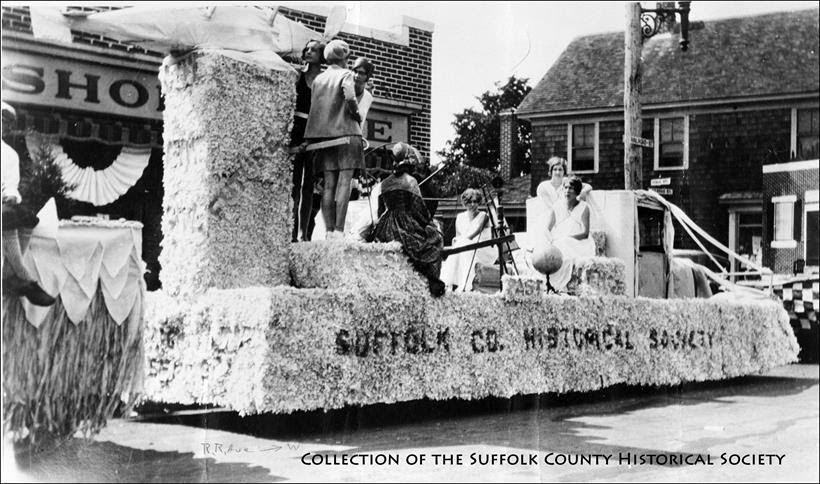
Suffolk County Historical Society Float, Labor Day Parade, Riverhead, August 28, 1928. Image from the SCHS Riverhead Pictorial Collection [173.24.11].
This photograph was taken by Ethel L. Sammis in 1928 in front of Iran’s Shoe Store, opposite the LIRR Station in Riverhead, when the SCHS was a mere 42 years old. On October 28, 1886, the Suffolk County Historical Society adopted its constitution and elected its first officers. On that same date, President Grover Cleveland dedicated the Statue of Liberty in New York City. In 2016, the Suffolk County Historical Society and the Lady in New York Harbor will both celebrate their 130th birthdays!
——————————- Interested in seeing more historical photos from the Collections of the Suffolk County Historical Society? Spend an afternoon at our Local History Library perusing our extensive archival photography collections. We’re open Weds. – Sat., 12:30 – 4:30 PM.
The Suffolk County Historical Society’s PHOTO OF THE WEEK is created by librarian Wendy Polhemus-Annibell using historic primary source materials from our local history library’s extensive archives. To subscribe, visit our website or send an email request to wannibell@schs-museum.org
MEMBERSHIP DRIVE
The Suffolk County Historical Society, founded in 1886, collects and preserves the rich history of Suffolk County and beyond. We offer a history museum, an expansive research library and archives, and a multitude of exhibits, events, programs, and educational lectures and workshops year-round. Our unique collections reflect more than three centuries of Long Island history.
For Member Benefits and a Membership Form, or call 631-727-2881. Thank you for your support!
————————————————————-
SCHS Photo of the Week: Click Here To View Original Photo of the Week — October 17, 2014 — Web Page.
_______________________________________________________
PHOTO OF THE WEEK: Oct. 10, 2014 — FROM THE SCHS LIBRARY ARCHIVES
If you’ve been enjoying our Photo of the Week series, please consider becoming a member of the Suffolk County Historical Society. Visit our website or call 727-2881 for details.
Sands Point Lighthouse, 1898
To View Fullerton Photograph of the Sands Point Lighthouse visit the Suffolk County Historical Society website — www.suffolkcountyhistoricalsociety.org.
The Sands Point Lighthouse, the fourth lighthouse to be established on Long Island, is located in the village of Sands Point in the Town of North Hempstead. Among the early settlers of the area was the family of Sands, who were very large landowners and held a large tract about Sands Point, which took its name from them. The original stone tower of Sands Point Light was built in 1809 by the U.S. government on five acres of land. It was constructed by Revolutionary War Captain Noah Mason, who stayed on as its first keeper for many years. During the War of 1812, from the lighthouse tower, Mason watched a naval battle between the British frigate Acosta and thirty American gunboats. Mason remained the keeper of the light until his death in 1841. INFO. SOURCE: William S. Pelletreau, A History of Long Island: From Its Earliest Settlement to the Present Time, vol. 2 (New York: Lewis Pub. Co., 1903). ____________________ SOME PAST PHOTOS OF THE WEEK Donaldson’s General Store, Hauppauge, 1906 LIRR Experimental Farm Exhibit at Brooklyn YMCA, 1910 Edward Thompson Fishing from Daniel Webster’s Bridge, Smithtown, May 1903 Judge Griffing, Grangebel Park, Riverhead, 1908 Montauk Lighthouse & Wainscott Mill, c. 1922 Mattituck High School Class of 1918 Avery’s Beach, Blue Point, 1912 Manor of St. George Patent, 1697 Capt. Henry Green, 1824 Walt Whitman, 1819-1892 Camp Dunes: Lake-by-the-Sea, Peconic, c. 1920s Central Islip School, c. 1898 Lady Suffolk, the Old Gray Mare from Commack Oyster Sloops at New Suffolk, c. 1900 The Gates to Sagtikos Manor, West Bay Shore, 1950s Vanderbilt Cup Race, Jericho, 1904 Memorial Day, Riverhead, 1920 Long Dock, Patchogue, 1898 Sag Harbor Toll House, 1800s Tuthill House, Jamesport, 1880s LIRR Train to Wading River, 1906 Greenport Group Portrait, 1890s Riverhead Fire Dept. Brass Band, 1910 Riverhead Woman’s Club Spring Luncheon, 1933 L.I. Women’s History: Edith Loring Fullerton (1876-1931) Long Island Suffrage Wagon, c. 1913 Local Suffragists, 1913 Pero, a Southold Slave: Receipt and Manumission Promise by Thomas Youngs, 1818 Blooming Roses on Arbors, Medford, c. 1916 The Schooner Long Island on Grass at Inlet, Sea Cliff, 1897 Scooter Race on Bellport Bay, c. 1900 Cottage on Banks of Titus Mill Pond, Centerport, c. 1904 ——————————- Interested in seeing more historical photos from the Collections of the Suffolk County Historical Society? Spend an afternoon at our Local History Library perusing our extensive archival photography collections. We’re open Weds. – Sat., 12:30 – 4:30 PM. The Suffolk County Historical Society’s PHOTO OF THE WEEK is created by librarian Wendy Polhemus-Annibell using historic primary source materials from our local history library’s extensive archives. To subscribe, visit our website or send an email request to wannibell@schs-museum.org MEMBERSHIP DRIVE The Suffolk County Historical Society, founded in 1886, collects and preserves the rich history of Suffolk County and beyond. We offer a history museum, an expansive research library and archives, and a multitude of exhibits, events, programs, and educational lectures and workshops year-round. Our unique collections reflect more than three centuries of Long Island history. For Member Benefits and a Membership Form, or call 631-727-2881. Thank you for your support!
——————-
SCHS Photo of the Week: Click Here To View Original Photo of the Week — October 10, 2014 — Web Page.
__________________________________________________________________
PHOTO OF THE WEEK: Sept. 19, 2014 FROM THE SCHS LIBRARY ARCHIVES
If you’ve been enjoying our Photo of the Week series, please consider becoming a member of the Suffolk County Historical Society. Visit our website or call 727-2881 for details.
[To see Hal T. Fullerton Photo — Edward Thompson Fishing from Daniel Webster’s Bridge, Smithtown, May 1903, please visit:
http://preview.cmail1.com/t/ViewEmail/d/CA5578E6CEEF57CE/728CE32B764D88692540EF23F30FEDED ]
Daniel Webster’s Bridge, Smithtown
(Edward Thompson Fishing from Daniel Webster’s Bridge, Smithtown, May 1903, by Hal B. Fullerton. Image from the SCHS Harry T. Tuthill Fullerton Collection [149.7.212], copyright © 2011 Suffolk County Historical Society. All rights reserved.)
That weatherbeaten shingled house with white trim on the south side of Jericho Turnpike in Smithtown, just east of Old Willets Path, is known as the Vail or Webster House. Today, Webster Pond is part of Caleb Smith State Park, but for many years in the nineteenth century, Aaron Vail (1801-1881) kept the house and Webster Pond as entertainment for trout fishermen, including Daniel Webster (1782-1852), long-time U.S. senator and a presidential contender.
Edward Thompson (b. 1845), pictured here in 1903 fishing at Webster Pond, went to work at the St. Johnland Home in the town of Smithtown in 1867 and eventually rose to Outdoor Superintendent there. In 1882, the ambitious Thompson left St. Johnland to found Edward Thompson Publishing Company in Northport, which became one of the world’s leading law book publishers. He retained close ties with Smithtown, however, where he established hatcheries and fish ponds. He was also a member of the Wyandanch Club and the Rasapeague Club, sportmen’s clubs located several miles apart on the Nissequogue River. Thompson’s interest in and knowledge of fishing and fisheries also led to his 1895 appointment as a NY State Fisheries, Game, and Forest Commissioner.
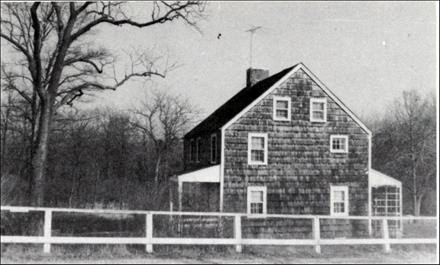
Webster House Vail or Webster House, Jericho Turnpike, Smithtown, 1962.
INFO. SOURCES: Colonel Rockwell’s Scrap-book (Smithtown Historical Society, 1968); Mitchell C. Harrison, New York State’s Prominent and Progressive Men, Vol. 2 (New York Tribune, 1900).
————————————————–
“Hal B. Fullerton: Crisp Images from a Faded Long Island Past” The New York Times | May 3, 2013
“Mr. Fullerton was a great documenter of Long Island, but he was also a great photographer.” —Neil Scholl, Huntington photographer
“Anyone interested in exploring the visual landscape or iconography of Long Island’s past will find the photographs of Hal B. Fullerton…immensely valuable. Fullerton’s work was so extensive, inclusive, and pervasive that it is difficult to imagine the Island’s appearance at the turn of the twentieth century without subconsciously conjuring up his pictures.” —Charles L. Sachs, The Blessed Isle
—————————
_______________________________________________
PHOTO OF THE WEEK: Sept. 12, 2014 FROM THE SCHS LIBRARY ARCHIVES
If you’ve been enjoying our Photo of the Week series, please consider becoming a member of the Suffolk County Historical Society. Visit our website or call 727-2881 for details.
Judge Griffing in Grangebel Park, Riverhead, c. 1908

Judge Griffing in Grangebel Park, Riverhead, c. 1908. Image from the Carleton Kelsey Postcard Collection of the Suffolk County Historical Society Library Archives.
Timothy Griffing graduated from Yale College in 1894 and served as Suffolk County Court Judge from 1907 to 1912. He married Caroline Perkins and had five children. Mr. Griffing turned this area of downtown Riverhead into a private park, reconstructing the dam and planting an array of beautiful trees, shrubs, and flowering plants. He named the park “Grangebel Park” after his three daughters–Grace, Angeline, and Mabel. The park was open to the public from an entrance on Main Street.
———————————————————————-

Join us for the first annual Edgar Allan Poe Festival
in Downtown Riverhead, Halloween weekend, Oct. 31 – Nov. 2.
Our Edgar Allan Poe Exhibit will officially open at Suffolk County Historical Society with a ceremony and Tales of Terror on Saturday, Nov. 1 at 12:00 PM. Classic Poe tales will be read all weekend at SCHS. More information: http://riverheadbid.com/edgar-allan-poe-festival-halloween/
—————————
_______________________________________________
PHOTO OF THE WEEK: September 5, 2014 From the SCHS Library Archives
Montauk Point Lighthouse & Wainscott Mill, c. 1922
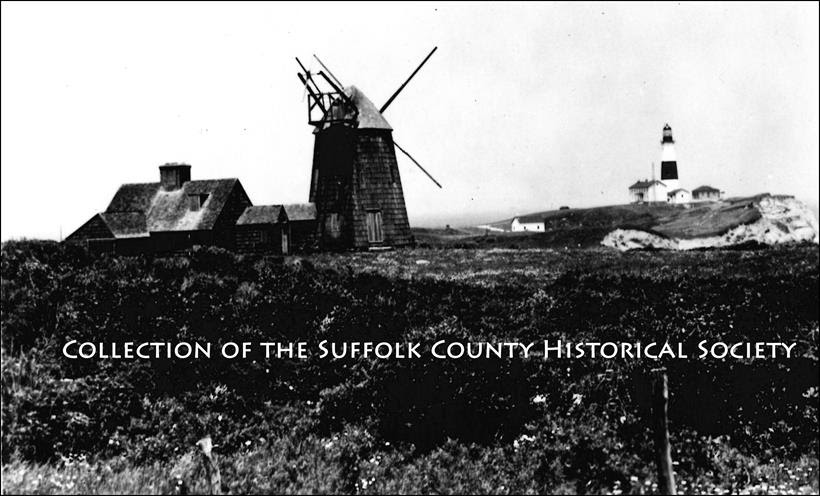
Montauk Lighthouse with Wainscott Mill in foreground, c. 1922. Image from the East Hampton Pictorial Collection of the Suffolk County Historical Society [204.4.3].
Montauk Light was the first lighthouse in New York State and is the fourth-oldest active lighthouse in the United States. Construction of the lighthouse was authorized by the 2nd U.S. Congress, under President George Washington, on April 12, 1792, and was completed on November 5, 1796. Ezra L’Hommedieu, who had been a member of the Continental Congress, consulted with Washington on the lighthouse construction. Due to prevailing winds in winter, shippers approaching from sea needed a lighthouse at the tip of Long Island to guide them along the south shore into New York Harbor.
Mill at Montauk Point: In the foreground of this photograph is the summer home of U.S. Representative Lathrop Brown (1922). The windmill portion of the home was built in Southampton in 1813 and moved to Wainscott in 1852; it was thereafter moved by Mr. Brown to Montauk Point in 1922. When the Brown property and other properties in Montauk were taken over by the U.S. government in 1942 during WWII, the Mill at Montauk Point was returned to Wainscott. One of eleven surviving eighteenth- and early nineteenth-century wind-powered mills on Long Island, the Wainscott Windmill was added to the National Historic Register in 1978.
Surviving centuries of time, historic wooden windmills built by skilled artisans and reminiscent of old-time England dot the landscape of Suffolk County’s lush East End. Few of this style of windmill remain in the United States; in fact, local historians claim that Long Island holds the largest number of windmills of this type in any one place. The windmills found on our historic island were constructed in the “smock mill” style, so-called because their skirted design resembles a baker’s smock.
INFO SOURCES: Jeannette Edwards Rattray, The Old Hook Mill and Other Old English Windmills of East Hampton (Village of East Hampton, 1942); vertical file, undated newspaper clippings.
—————————
SCHS Photo of the Week: Click Here To View Original Photo of the Week — August 29, 2014 — Web Page.
_____________________________________________________
PHOTO OF THE WEEK: August 29, 2014 FROM THE SCHS LIBRARY ARCHIVES
If you’ve been enjoying our Photo of the Week series, please consider becoming a member of the Suffolk County Historical Society. Visit our website or call 727-2881 for details.
Mattituck High School Class of 1918
Mattituck High School Class of 1918. From the Collection of the Suffolk County Historical Society.
Faculty and Class of 1918, from left to right: Top row – Teachers Elida Armstrong, Ethel Wight, and Robert Hughes. Middle row – Seniors Earl H. Fischer (Valedictorian), Howard Griswold Beebe (Class Prophet), J. Frank Gagen (Class Historian), and Sidney Preston Tuthill (Class President). Front row – Hazel Beebe Tuthill (Poet), Adelaide Honor Satterly (Class Treasurer), Lois Edna Morrell (Class Secretary), and Clara Elizabeth Duryee (Class Vice President).
The MHS Hall of Fame list included students from the senior, junior, sophomore, and senior classes in 1918.
Published by the students of Mattituck High School, June 1918
—————————
SCHS Photo of the Week: Click Here To View Original Photo of the Week — August 29, 2014 — Web Page.
_____________________________________________________
PHOTO OF THE WEEK: August 22, 2014. FROM THE SCHS LIBRARY ARCHIVES.
If you’ve been enjoying our Photo of the Week series, please consider becoming a member of the Suffolk County Historical Society. Visit our website or call at 727-2881 for details.
Great South Bay, Avery’s Beach, Blue Point, c. 1912
 Great South Bay, Avery’s Beach, Blue Point, c. 1912. From the Brookhaven Town Pictorial Collection of the Suffolk County Historical Society [202.1.37].
Great South Bay, Avery’s Beach, Blue Point, c. 1912. From the Brookhaven Town Pictorial Collection of the Suffolk County Historical Society [202.1.37].
Avery’s Dock, also known as Five Mile Look, was built in the early twentieth century and was destroyed by fire in 1939.
The name “Blue Point” may have been first used by seventeenth-century baymen who noticed a distinct blue haze over this point of land that juts out into the Great South Bay. Some claim that the name dates back to when local Native Americans made wampum from the blue chips of the seashells found here.
In 1752, Humphrey Avery of Connecticut purchased the Blue Point and Patchogue areas from John Still Winthrop for £2600. In the early nineteenth century, Blue Point was rural and sparsely populated; most residents were farmers or baymen. There was no schoolhouse, post office, railroad, fire department, or churches at this time. Robust wild oysters were found in the local waters. As everywhere else, Blue Point oysters didn’t last long as New York City quickly devoured them. In 1824, the Gazetteer of NY State was referring to “Bluepoints” in the past tense.
By the turn of the twentieth century, Blue Point underwent major changes – two churches were built, the railroad added a depot, and the resort era began.
—————————
SCHS Photo of the Week: Click Here To View Original Photo of the Week — August 22, 2014 — Web Page.
_____________________________________________________
PHOTO OF THE WEEK: August 15, 2014 — from the SCHS LIBRARY ARCHIVES
If you’ve been enjoying our Photo of the Week series, please consider becoming a member of the Suffolk County Historical Society. Visit our website or call us at 727-2881 for details. 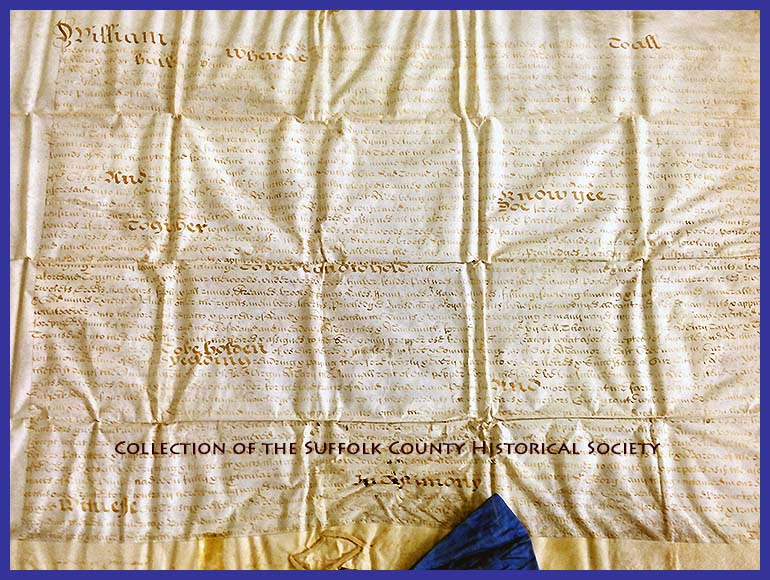
Original 1697 Land Grant for the Manor of St. George, Shirley, NY. Ink on vellum. From the Collection of the Suffolk County Historical Society.
Original 1697 Land Grant for the Manor of St. George, Shirley
This patent for the Manor of St. George was granted by Governor Fletcher of New York to Colonel William “Tangier” Smith in 1697. One of the best-preserved 17th-century documents in our library archives, it is currently on display in our From Manor to Museum: Treasures of Sagtikos Manor exhibit, which runs through November 8.
The Manor of St. George is an important chapter in the history of Long Island, the United States, and the colonies that preceded them. Colonel William Smith had filed application with the governor, formally petitioning that his estate be erected into a manor to be known as the Manor of St. George. In those days in New York’s rural districts, many great manorial estates came into being. The proprietor was known as the Lord of the Manor and that title denoted an ownership of land invested with ancient and extensive privileges.
For more than three centuries, the Manor of St. George was occupied by the Col. William Tangier Smith family. The Manor was also the scene of a famous revolutionary war battle: After the British captured Long Island in the War of 1776, the Manor of St. George became Fort St. George, a British-held bastion and supply base for land and sea forces, because of its proximity to the inlet that then existed in the barrier beach opposite Mastic, and because the British coveted the wood in its forests. Fort St. George was short-lived in British hands: in 1780, it was recaptured in a surprise 4 a.m. attack by American forces led by Col. Benjamin Tallmadge.
 The Manor of St. George overlooks the Great South Bay and is located off William Floyd Pkwy.
The Manor of St. George overlooks the Great South Bay and is located off William Floyd Pkwy.  —————————— Interested in seeing more historical photos from the Collections of the Suffolk County Historical Society? Spend an afternoon at our Local History Library perusing our extensive archival photography collections. We’re open Weds. – Sat., 12:30 – 4:30 PM. The Suffolk County Historical Society’s PHOTO OF THE WEEK is created by our librarian, Wendy Polhemus-Annibell, using historic materials from our local history library’s extensive and varied archives. To subscribe, visit our website or send an email request to: wannibell@schs-museum.org —————————— MEMBERSHIP DRIVE The Suffolk County Historical Society, founded in 1886, collects and preserves the rich history of Suffolk County and beyond. We offer a history museum, an expansive research library and archives, and a multitude of exhibits, events, programs, and educational lectures and workshops year-round. Our unique collections reflect more than three centuries of Long Island history. For Member Benefits and a Membership Form call 631-727-2881. Thank you for your support!
—————————— Interested in seeing more historical photos from the Collections of the Suffolk County Historical Society? Spend an afternoon at our Local History Library perusing our extensive archival photography collections. We’re open Weds. – Sat., 12:30 – 4:30 PM. The Suffolk County Historical Society’s PHOTO OF THE WEEK is created by our librarian, Wendy Polhemus-Annibell, using historic materials from our local history library’s extensive and varied archives. To subscribe, visit our website or send an email request to: wannibell@schs-museum.org —————————— MEMBERSHIP DRIVE The Suffolk County Historical Society, founded in 1886, collects and preserves the rich history of Suffolk County and beyond. We offer a history museum, an expansive research library and archives, and a multitude of exhibits, events, programs, and educational lectures and workshops year-round. Our unique collections reflect more than three centuries of Long Island history. For Member Benefits and a Membership Form call 631-727-2881. Thank you for your support!
—————————
SCHS Photo of the Week: Click Here To View Original Photo of the Week — August 15, 2014 — Web Page.
_____________________________________________________
PHOTO OF THE WEEK: August 8, 2014 — from the SCHS LIBRARY ARCHIVES
If you’ve been enjoying our Photo of the Week, please consider becoming a member of the Suffolk County Historical Society.
Capt. Henry Green of Sag Harbor and Peconic, 1824 
Captain Henry Green, 1824, by Hubbard L. Fordham of Sag Harbor. Oil on canvas. From the Collection of the Suffolk County Historical Society [206.2592].
Born in Sag Harbor in 1794, Henry Green served as whaling captain of numerous ships during his twenty-six-year tenure in that occupation. He married Roxanna Stewart Fordham of Sag Harbor, and in 1851 he moved with his large family to a home on Main Road, Peconic, opposite Skunk Lane. The home still stands today, and was among a row of Main Road residences occupied by retired whaling captains.
On August 26, 1839, the Spanish schooner Amistad dropped anchor off Montauk, and as sea captains Henry Green and Pelatiah Fordham were shooting birds in the area, they came across the African shore party. The Africans told the men, through sign language, that there were two great chests of gold aboard that they would give anyone who supplied them with provisions and helped them get back to Africa. For more on the Amistad story, visit web page link below.
During the War of 1812, Henry Green served as Private to Captain David Hedges’ Co. Militia; upon his retirement, Green collected an $8 per month pension from the Dept. of the Interior. He died in 1873 and is buried at Oakland Cemetery in Sag Harbor.

War of 1812 Pension Certificate No. 2453, issued August 10, 1871, by the Pension Office of the U.S. Dept. of the Interior to Henry Green of Peconic, NY. [From the Collection of the Suffolk County Historical Society.]
—————————
SCHS Photo of the Week: Click Here To View Original Photo of the Week — August 8, 2014 — Web Page.
_____________________________________________________
PHOTO OF THE WEEK: August 1, 2014. FROM THE SCHS LIBRARY ARCHIVES
————————
If you’ve been enjoying our Photo of the Week, please consider becoming a member of the Suffolk County Historical Society.
————————
Walt Whitman, 1819-1892
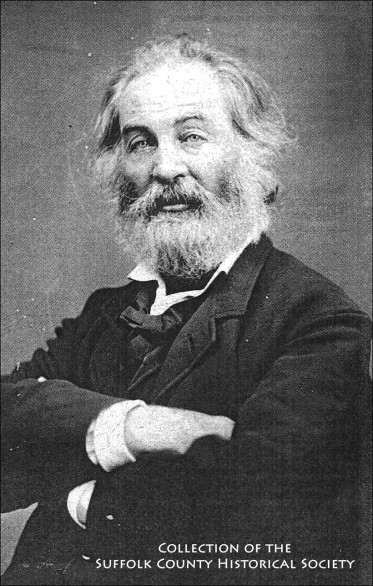
Walt Whitman
[Image from the Huntington Pictorial Collection of the Suffolk County Historical Society.]
Born on Long Island on May 31, 1819, to Walter Whtiman, a Quaker carpenter, and his wife Louisa Van Velsor Whitman, a descendant of Dutch farmers, Walt Whitman is our most celebrated local poet.
Early in his life Whitman worked as a school teacher and printer and served as writer and editor for the Brooklyn Eagle newspaper. He continued to work various jobs, writing and working as a carpenter, and in 1839 he founded The Long Islander, a Huntington weekly newspaper.
In 1855 Whitman published his now well-known collection of 12 poems titled Leaves of Grass. He would continue to revise and add to Leaves of Grass until his death in 1892, at which point the final collection grew to include over 400 poems. Regarded as offensive and even vulgar at the time for its outspoken sexual content, the poems celebrate democracy, individuality, and the richness of life. Whitman believed as well that the advent of photography during his lifetime brought a new democratic way of viewing both people and the world.
In 1862 Whitman traveled to Virginia to find his brother George, who had been wounded in the Civil War. He was shocked to witness the horrors of war firsthand and was deeply affected by the suffering of the wounded. He worked as a nurse in army hospitals in Washington, D.C., caring first for his brother and then for other soldiers.
In these lines from “Crossing Brooklyn Ferry,” which originally appeared as “Sun-Down Poem” in an early edition of Leaves of Grass, Whitman speaks directly to future generations about the beauty of the East River sunset:
It avails not, time nor place–distance avails not, I am with you, you men and women of a generation, or ever so many generations hence, Just as you feel when you look on the river and sky, so I felt, Just as any of you is one of a living crowd, I was one of a crowd, Just as you are refreshed by the gladness of the river and the bright flow, I was refreshed … I too many and many a time crossed the river of old, Watched the Twelfth-month sea-gulls, saw them high in the air floating with motionless wings, oscillating their bodies, Saw how the glistening yellow lit up parts of their bodies and left the rest in strong shadow … Saw the reflection of the summer sky in the water … The scallop-edged waves in the twilight … These and all else were to me the same as they are to you…
— from Crossing Brooklyn Ferry by Walt Whitman
 Sketch of Walt Whitman’s birthplace, West Hills, Long Island, NY. [Image from the Huntington Pictorial Collection of the Suffolk County Historical Society: 207.00.339.]
Sketch of Walt Whitman’s birthplace, West Hills, Long Island, NY. [Image from the Huntington Pictorial Collection of the Suffolk County Historical Society: 207.00.339.]
—————————
SCHS Photo of the Week: Click Here To View Original Photo of the Week — July 29 — Web Page.
———————————————————————————————————————–
PHOTO OF THE WEEK: July 25, 2014 FROM THE SCHS LIBRARY ARCHIVES
Camp Dunes: Lake-by-the-Sea, Peconic, c. 1920s
Camp Dunes: Lake-by-the-Sea, Peconic, Long Island, c. 1920s For Girls Fourteen to Eighteen Years of Age Camp Season: July 1 – August 27
——————————————-
Camp Dunes was located on over 26 acres on the Long Island Sound and included access to Great Pond Lake. The camp was owned and operated by Luvia Willard, M.D., of Jamaica, NY (who also owned a home on Great Pond Lake); Marian Wood of Philadelphia was co-director. The rate was $150 for 8 weeks of summer camp, according to an ad in the Long Island Daily Press (June 17, 1924).
Food for the camp was purchased from neighboring farms and village markets, and the female campgoers engaged in various activities: swimming, boating, play-acting, and the like – as this series of images from an extensive photo album in our collection depicts.
“The maritime climate together with the unusual amount of sunshine peculiar to this locality make for an unusually healthful environment. The Geodetic Survey shows that the region around Peconic, Long Island, averages to the year one hundred days more sunshine than New York City,” notes a Camp Dunes brochure in our collection, which also features this poem:
Far from the city’s maddening din, Out where the Sunrise Trails begin, Where the toes of the dunes are kissed by the sea, Is a camp that seems just made for me.
Where the birches dress in their silvery white, And gnarled oaks squirm in sheer delight, Where tall pines frame a sapphire sea, Is a camp that seems just made for me.
There are hill camps, and lake camps, and camps by the sea, But there’s only one camp by the lake and the sea.
—————————
SCHS Photo of the Week: Click Here To View Original Photo of the Week — July 11 — Web Page.
———————————————————————————————————————–
PHOTO OF THE WEEK: July 18, 2014 FROM THE SCHS LIBRARY ARCHIVES
Central Islip School, Wheeler Road, c. 1898
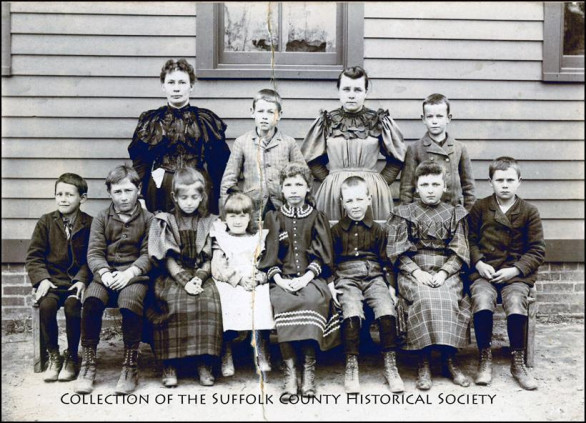
Central Islip School, Wheeler Road, c. 1898. Image from the SCHS Islip Pictorial Collection [173.11.9].
Pictured here at Central Islip School in circa 1898 are school teacher Miss Monk with her students: in the back row, Albert and Herbert Marshall (their father worked at the State Hospital), and Wilhelmina Heines (sister of Henry, born 1881); in the front row (left to right): Adams?, George Stamps, Ruth Hatch, Mary Alice Miller, Grace Hubbs, Albert Miller, Phoebe Holmes, and Henry Heines (born 1883).
According to the Islip Town Record, Miss Monk was Central Islip School’s teacher for three or four years, and then returned to the area some years later after falling in love:
Central Islip: The gossips of this village had a genuine surprise last Sunday. Walham S. Davis had bought a lot and built a cottage on it. Being a single man, the gossips said: “He has the cage; he must have a bird in view, but who is it?” He seemed to be a general favorite with the ladies, paying equal attention to them all. So last Sunday he went to Brooklyn, and returned in the evening, bringing as his bride one who was the least suspected of having won his heart–Miss Burnice I. Monk! Miss Monk was a school teacher for three years in Central Islip, her term ending about four years ago. We are all glad to welcome her back in her new position. May their joys be great, and their cares be small ones. The neighbors gave Mr. and Mrs. Davis an old-fashioned serenade on Tuesday night, which woke up the town” (Islip Town Record, Jan. 11, 1902, p. 2).
Prior to the arrival of European settlers, the Secatogue tribe of the Algonquins lived in the area now known as Central Islip. In 1842, the Long Island Rail Road’s eastward expansion reached the area, and the Suffolk County Station was opened in Central Islip. The station became the commercial center for the area, and the name “Central Islip” was born.
—————————
SCHS Photo of the Week: Click Here To View Original Photo of the Week — July 11 — Web Page.
———————————————————————————————————————–
PHOTO OF THE WEEK: July 11, 2014 FROM THE SCHS LIBRARY ARCHIVES
———————————————————————-
The Suffolk County Historical Society is very pleased to announce that we are the recipient of a $50,000 grant from the Robert David Lion Gardiner Foundation for the restoration of our new East Wing gallery space! Established in 1987, the Foundation supports New York State and Suffolk County history. Robert D.L. Gardiner was, until his death in 2004, the 16th Lord of the Manor of Gardiner’s Island.
———————————————————————-
Adult Swimmers, 1897, by Hal. B. Fullerton
To view Fullerton photo, visit web link below
Adult Swimmers on Float, Wreck Lead Doctors Club, Undine Club Group, 1897, by Hal B. Fullerton. Image from the SCHS Harry T. Tuthill Fullerton Collection [149.7.957], copyright © 2011 Suffolk County Historical Society. All rights reserved.
———————————————–
“Hal B. Fullerton: Crisp Images from a Faded Long Island Past” The New York Times | May 3, 2013
“Mr. Fullerton was a great documenter of Long Island, but he was also a great photographer.” —Neil Scholl, a Huntington photographer
“Anyone who is interested in exploring the visual landscape or iconography of Long Island’s past will find the photographs of Hal B. Fullerton…immensely valuable. Fullerton’s work was so extensive, inclusive, and pervasive that it is difficult to imagine the Island’s appearance at the turn of the twentieth century without subconsciously conjuring up his pictures.” —Charles L. Sachs, The Blessed Isle
—————————
SCHS Photo of the Week: Click Here To View Original Photo of the Week — July 11 — Web Page.
———————————————————————————————————————–
PHOTO OF THE WEEK: 4TH OF JULY 2014 FROM THE SCHS LIBRARY ARCHIVES
‘Tis the Birthday of Liberty! Ode for the Fourth of July, 1851
 Ode for the Fourth of July, 1851, by Mrs. Mary L. Gardiner. Printed at The Corrector Office, Sag-Harbor. From the Collection of the Suffolk County Historical Society Library & Archives.
Ode for the Fourth of July, 1851, by Mrs. Mary L. Gardiner. Printed at The Corrector Office, Sag-Harbor. From the Collection of the Suffolk County Historical Society Library & Archives.
Mary L. Gardiner of Sag Harbor published The Prose and Poetical Writings of Mary L. Gardiner in 1843 (New York: J. Winchester, Printer), dedicating the volume to Benjamin P. Thompson, her “early friend and patron.” “The author of this miscellaneous collection (many parts of which have appeared in different publications), is, but to a small extent, known to fame, and possesses no inordinate ambition for distinction as a writer, beyond the limits of her native island.”
——————————-
SCHS Photo of the Week: Click Here To View Original Photo of the Week — July 4 — Web Page. ________________________________________________________________________
PHOTO OF THE WEEK: June 27, 2014 FROM THE SCHS LIBRARY ARCHIVES
Lady Suffolk, the Old Gray Mare of Long Island
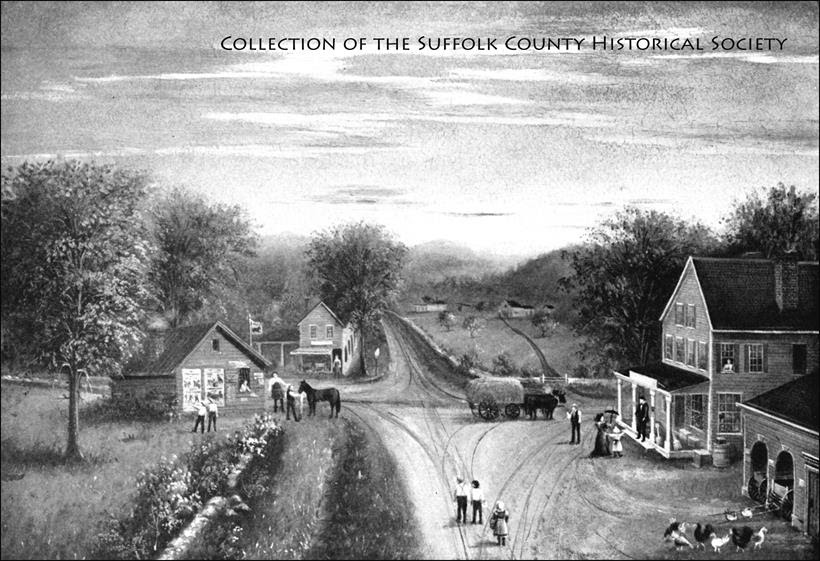 Crossroads at Jericho Turnpike, Commack, c. 1840 Codman’s Blacksmith Shop (lower left), where Lady Suffolk was often shod during the early years of her career. Image from a painting by an unknown artist. From the Collection of the Suffolk County Historical Society Library & Archives.
Crossroads at Jericho Turnpike, Commack, c. 1840 Codman’s Blacksmith Shop (lower left), where Lady Suffolk was often shod during the early years of her career. Image from a painting by an unknown artist. From the Collection of the Suffolk County Historical Society Library & Archives.
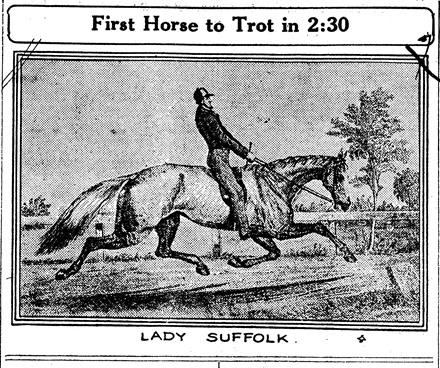 Lady Suffolk, the most famous and beloved trotting horse of the 19th century, was foaled at the Burr family farm in Commack in 1833. Her first race was in 1838, when she was 5 years old. She was campaigned throughout the United States for 15 years, engaging in 138 races and winning 88 of them! Her record was 2.26 minutes for a mile. She died in 1855 at the age of 22. Some maintain it was for Lady Suffolk that the song “The Old Gray Mare” was written.
Lady Suffolk, the most famous and beloved trotting horse of the 19th century, was foaled at the Burr family farm in Commack in 1833. Her first race was in 1838, when she was 5 years old. She was campaigned throughout the United States for 15 years, engaging in 138 races and winning 88 of them! Her record was 2.26 minutes for a mile. She died in 1855 at the age of 22. Some maintain it was for Lady Suffolk that the song “The Old Gray Mare” was written.
——————————-
SCHS Photo of the Week: Click Here To View Original Photo of the Week — June 27 — Web Page. ________________________________________________________________________
PHOTO OF THE WEEK: June 20, 2014 FROM THE SCHS LIBRARY ARCHIVES
Oyster Sloops at New Suffolk
New Suffolk, a small hamlet on the North Fork of Long Island situated just south of Cutchogue and a quarter mile north of Robin’s Island, is named after Suffolk County in England. In the seventeenth century the area was known as Booth’s Neck (John Booth was the first owner of most of the land), and in the eighteenth century it became known as Robin’s Island Neck. New Suffolk was at one time a busy port and shipyard, and in 1899-1905 was the base of the USS Holland (SS-1), the first U.S. Navy-commissioned submarine.
The cultivation of oysters was once a thriving industry. The Standard Oyster Co. was succeeded by the Radell Oyster Co. Originally, 40 men were employed, and a factory was built to make barrels for shipping the well-known Robins Island oysters all over the country.
The streets of New Suffolk were laid out in grid form in the mid-1800s. This image shows what we believe to be the house built by Ira Tuthill (1803-1898). In 1838, Ira Tuthill acquired by deed from NY State Governor William March the underwater lands and built New Suffolk’s largest dock. He also operated a brick factory on Robins Island, a lumber business in New Suffolk, a fleet of sailing vessels, and a general store on the corner of New Suffolk and Main roads in Cutchogue!
INFO. SOURCE: Marjorie M. Butterworth, The New Suffolk Story: Then, Now, and In-Between (Cutchogue: Cutchogue-New Suffolk Historical Council, 1983).
——————————-
SCHS Photo of the Week: Click Here To View Original Photo of the Week — June 20 — Web Page.
________________________________________________________________________
PHOTO OF THE WEEK: June 13, 2014 FROM THE SCHS LIBRARY ARCHIVES
Original Lloyd Harbor Lighthouse, c. 1905

Original Lloyd Harbor Lighthouse, c. 1905 Image from the Huntington Town Pictorial Collection of the Suffolk County Historical Society Library & Archives [173.14.1].
The original Lloyd Harbor Lighthouse was constructed in 1857 and consisted of a two-story, wood-frame dwelling built on a brick foundation and attached at one corner to a square brick tower. A kitchen, dining room, and sitting room were located on the first floor, and three bedrooms were available on the second floor. The original beacon was a fifth-order, Henry-Lepaute Fresnel lens showing a fixed white light at a focal plane of forty-eight feet. The first keeper listed for Lloyd Harbor Lighthouse was John S. Woods. He was replaced by Abiathar Johnson in 1875, and by Robert McGlone in 1885.
This Lloyd Harbor Lighthouse was eventually replaced by the Huntington Harbor Light, which was built in a nearby spot in Huntington Bay. In 1947, the original Lloyd Harbor Light that had stood for more than ninety years was lost in a fire.
——————————-
SCHS Photo of the Week: Click Here To View Original Photo of the Week — June 13 — Web Page. ________________________________________________________________________
PHOTO OF THE WEEK: June 6, 2014 — FROM THE SCHS LIBRARY ARCHIVES
The Gates to Sagtikos Manor, West Bay Shore

The Gates to Sagtikos Manor Image from the Sagtikos Manor Collection, courtesy Suffolk County Historic Services.
Who was this fashionably gorgeous woman posing at the gates of the historic Sagtikos Manor in circa 1950? The stunning image was recently discovered at the Sagtikos Manor estate along with many other never-before-seen photographs from the historic site. (Email your clues to the woman’s identity to wannibell@schs-museum.org, and I’ll report back next week!)
Come take your own photo in front of these very same Sagtikos Manor gates, which will be on exhibit at the Suffolk County Historical Society starting June 28 — more on that below!
Sagtikos is a Native American word meaning “head of the hissing snake” and is derived from the sound of a small stream that flows through the neck of land upon which the Manor house lies. The site’s history spans more than three centuries–from its original purchase from the Secatogue tribe by Stephanus Van Cortlandt in 1692 to the present day. Built in 1697, Sagtikos Manor served as headquarters for the British Army on Long Island for a time during the Revolutionary War, and President George Washington stayed here on April 21, 1790, during his tour of Long Island.
The 700-acre estate was acquired by Jonathan Thompson of Setuaket in 1758 for the sum of £1200 (British pounds). Mr. Thompson purchased the land for his son, Isaac, who in 1772 married Mary Gardiner from East Hampton. Jonathan deeded half of the land to Isaac upon the birth of Isaac and Mary’s first son in 1773, and the remainder of the property to Isaac upon Jonathan’s death. Judge Isaac Thompson was a prominent member of Islip Town government before and after the American Revolution.
The last family member to live in the Manor was Robert David Lion Gardiner, who owned the property from 1935 to 1985. He deeded it to the Robert David Lion Gardiner Foundation. In 2002 Suffolk County purchased the remaining 10-acre property from the Foundation.
 The earliest known sketch of Sagtikos Manor Image from the Collection of the Suffolk County Historical Society.
The earliest known sketch of Sagtikos Manor Image from the Collection of the Suffolk County Historical Society.
FROM MANOR TO MUSEUM: Treasures of Sagtikos Manor Exhibit – June 28 to September 13
The Manor house is furnished with original family pieces just as it was when the last owner moved out in 1963. Many of these historic items – furniture, costumes, decorative arts, photographs, documents, and the wrought-iron entrance gates, among other pieces – will be on exhibit at the Suffolk County Historical Society from June 28 to September 13.
Opening Reception: Saturday, June 28, 6:00 PM
Gallery Hours: Tues. to Sat., 10:00 AM to 4:30 PM
——————————-
SCHS Photo of the Week: Click Here To View Original Photo of the Week — June 6 — Web Page.
________________________________________________________________________
PHOTO OF THE WEEK: May 23, 2014 FROM THE SCHS LIBRARY ARCHIVES
Memorial Day in Riverhead, 1920

World War I Monument, Riverhead, NY, 1920. Donated by the people of Riverhead Town, the solid granite block with bronze plaque made by J.W. Friske Iron Co. of New York contains the names of the 306 young men from Riverhead who served in World War I. The memorial was erected in 1920 in front of the first home of the Suffolk County Historical Society building at the northwest corner of Main Street and Griffing Avenue. It was dedicated by Col. Theodore Roosevelt of Oyster Bay on Memorial Day 1920. Today the monument stands at the corner of the SCHS’s Great Lawn at Main and Court streets. [Image from the SCHS Postcard Collection.]
Col. Theodore Roosevelt, Distinguished Soldier, Son of U.S. President, Dedicates WWI Monument in Riverhead on Memorial Day 1920 Col. Theodore Roosevelt of Oyster Bay delivered a stirring war and patriotic address at the unveiling of the monument. An immense crowd of people massed in front of the memorial at the junction of Main Street and Griffing Avenue to greet Col. Roosevelt. His car broke down on the way to Riverhead and he was delayed a considerable time, but after the several thousand people had heard his earnest words and the sincere way in which he delivered them, all felt that their wait had been well worthwhile. “It’s our dead and the sacrifices we make that count,” Col. Roosevelt declared. “If the sacrifices made in the Revolutionary War, the Spanish War, the Civil War and the war just ended mean anything they mean a heritage to all in the future, a responsibility on you and on me to see that what they did and what they fought for bears fruit and that the country gets what they fought for and goes forward in the way they wished and hoped. We should now be doubly careful to preserve that heritage. One of the great lessons taught by the war is a splendid democracy. It is a fine thing to realize that we are all on the same basis, the man with $2 or the man with $200,000, and we must all be on the same plane as real Americans, living up to our country’s highest ideals.” In unveiling the monument, Col. Roosevelt noted that it contained over 300 names and added: “I had no idea Riverhead had such a large list of service men.” Pointing out several Tuthills he asked if any were present, and an elderly, gray-haired woman with tears streaming down her face stepped up to him; she had lost a son in the war, George L. Tuthill. INFO. SOURCES: Excerpts from “Distinguished Soldier, Son of Famous Man, Gives Fine Memorial Day Address in Riverhead,” Riverhead News-Review, June 4, 1920, SCHS Library Historic Newspapers Collection.
 Daniel H. Tuthill (1897-1958)
Daniel H. Tuthill (1897-1958)
In World War I, Daniel Tuthill of Jamesport served overseas with the Ambulance Section of the U.S. Army and was the first soldier in Suffolk County to be awarded the French War Cross. [Image from the SCHS Riverhead Pictorial Collection.]
————————————————————
SCHS Photo of the Week: Click Here To View Original Photo of the Week — May 23 — Web Page.
______________________________________________________________
PHOTO OF THE WEEK: May 16, 2014. FROM THE SCHS LIBRARY ARCHIVES
At the turn of the twentieth century, Patchogue was a major tourist area with many hotels and boarding houses offering 1,600 beds to guests from New York City and beyond. With the arrival of train service in Patchogue in 1869, New Yorkers could escape the hot, crowded city for a relaxing weekend on the cool shores of the Great South Bay located just 56 miles from the city. The Clifton Hotel, located at the foot of Bay Avenue on the Great South Bay, was built in 1882; it was expanded in 1892 and 1896, doubling in size to accommodate the area’s booming tourism industry.
 Clifton Hotel, Patchogue.
Clifton Hotel, Patchogue.
Surrounding the Clifton were 10 acres of lawns, flower gardens, trees, and fascinating bay views. Guests enjoyed 600 feet of shorefront, a sandy beach, a 500-foot private pier, a 1/3-mile-long boardwalk promenade, and 3,000 square feet of veranda overlooking the bay. There were also a casino, a pool, an indoor bowling alley, 120 bath houses, a sun deck, and an Australian swimming pool! Yachts could be hired out for excursions on the bay or for travel to Fire Island and ocean beaches. Boats could be hired for gunning parties and fishing trips. It’s no wonder they called Patchogue the “Queen City” of Long Island’s South Shore! —————————————————– SCHS Photo of the Week: Click Here To View Original Photo of the Week — May 16 — Web Page.
________________________________________________________________
Interested in seeing more historical photos from the Collections of the Suffolk County Historical Society? Spend an afternoon at our Local History Library perusing our extensive archival photography collections. We’re open Weds. – Sat., 12:30 – 4:30 PM.
The Suffolk County Historical Society’s PHOTO OF THE WEEK is created by our librarian, Wendy Polhemus-Annibell, using historic materials from our local history library’s extensive and varied archives. To subscribe, please send an email request to: wannibell@schs-museum.org
MEMBERSHIP DRIVE
The Suffolk County Historical Society, founded in 1886, collects and preserves the rich history of Suffolk County and beyond. We offer a history museum, an expansive research library and archives, and a multitude of exhibits, events, programs, and educational lectures and workshops year-round. Our unique collections reflect more than three centuries of Long Island history.
Visit www.suffolkcountyhistoricalsociety.org for Member Benefits and a Membership Form, or call 631-727-2881. Thank you for your support!
________________________________________________________________
PHOTO OF THE WEEK: May 9, 2014 FROM THE SCHS LIBRARY ARCHIVES
BULL’S HEAD TOLL HOUSE, 1880S
 Bull’s Head Toll House, 1800s. Bridgehampton-Sag Harbor, 1800s. Image from the SCHS Southampton Pictorial Collection.
Bull’s Head Toll House, 1800s. Bridgehampton-Sag Harbor, 1800s. Image from the SCHS Southampton Pictorial Collection.
Most nineteenth-century Long Island roads were in poor condition from horses and buggies, stagecoaches, and teams of animals that caused deep mud-filled ruts in the rainy season and dusty conditions during the summer months. Early in the century the state had not yet assumed the building and maintaining of roads, and the toll system was devised to raise funds for road maintenance. From Bridgehampton to Sag Harbor, tolls were collected at the Bull’s Head toll house, which stood on the west side of the Sag Harbor Turnpike about two miles from the business district. Daniel McCullin and his family occupied the house and collected the toll for every horse, carriage, and team of animals that passed through. For every wagon drawn by two horses, mules, or oxen, the cost was 8 cents – and every additional horse, mule, or oxen would cost an additional 2 cents. A wagon drawn by one horse was a 4-cent toll, and a score of cattle 10 cents. There were actually two toll gates to Sag Harbor, the other being on the East Hampton side, as can be viewed in the accompanying 1858 map section. After the railroad was built and extended to the area in 1870, the turnpike road deteriorated. In 1905, the Bull’s Head gate was removed and the following year Southampton Town became responsible for the maintenance of the turnpike. Finally, in 1909, the toll house was destroyed by fire, but the toll board was saved and donated to the Sag Harbor Whaling Museum.
 Toll Gates Marked on 1858 John Douglass Map. Map of Suffolk County, L.I., New York (Philadelphia: John Douglass, Publisher, 1858).
Toll Gates Marked on 1858 John Douglass Map. Map of Suffolk County, L.I., New York (Philadelphia: John Douglass, Publisher, 1858).
SOURCES: Paul H. Curts (ed.), Bridgehampton’s Three Hundred Years (Bridgehampton, NY: Hampton Press, 1956); Dorothy I. Zaykowski, Sag Harbor (Sag Harbor, NY: Sag Harbor Historical Society, 1991). Map of Suffolk County, L.I., New York (Philadelphia: John Douglass, Publisher, 1858). —————————————————– SCHS Photo of the Week: Click Here To View Original Photo of the Week — May 9 — Web Page. ________________________________________________________________
|
|
|
|
PHOTO OF THE WEEK: March 22, 2014, FROM THE SCHS LIBRARY ARCHIVES  L.I. Women’s History: L.I. Women’s History: |
Edith Loring Fullerton (1876-1931)
Edith Loring Fullerton, together with her husband, Hal B. Fullerton, the LIRR promoter and agriculturalist known for his extraordinary photographs of early twentieth-century Long Island, operated experimental farms in Wading River (1905) and Medford (1908) for the Long Island Rail Road. At Peace and Plenty Farm in Wading River, Edith tended to the gardens, preserved fruits and vegetables, made fruit jams, oversaw the household, ran the office, hand-colored Hal’s glass-plate negatives–and even helped clear the land by dynamiting tree stumps! In her book The Lure of the Land (1906), Edith provides a detailed account of the family’s first year at the Peace and Plenty Farm; the book documents “the history of a market-driven and dairy plot developed within eight months upon Long Island’s idle territory, long designated as scrub oak waste” (p. i). In one part of the book, Edith describes the blowing up of tree stumps with dynamite (powered by battery) as “a most delightful Fourth of July firecracker exhibition on a large scale. Roots are thrown up out of sight and return to earth a hundred or more feet from the place in which they grew, while the air is filled with minute fragments of wood and powdered earth. Our record for stump blowing is 130 in one day, when 84 pounds of dynamite was used!” (p. 19). Edith Fullerton eventually succeeded her husband when he retired as Special Agent for the railroad. In 1915, she was appointed Assistant Director of Agriculture, becoming the first woman executive at the LIRR. INFO. SOURCES: Edith Loring Fullerton, The Lure of the Land: A Call to Long Island (New York: The Long Island Railroad Co., 1906); Charles L. Sachs, The Blessed Isle: Hal B. Fullerton and His Images of Long Island, 1897-1927 (Interlaken, NY: Heart of the Lakes Publishing, 1991).
______________________________________________________________
|
PHOTO OF THE WEEK: March 14, 2014 FROM THE SCHS LIBRARY ARCHIVES |
Long Island Women’s HistoryA Tribute to the Beauty and Charm of Phebe McCoon, 1804 |
 |
|
Phebe McCoon (1786-1868), Silhouette, c. 1820. In the early 1800s, Timothy Dwight, president of Yale College, chronicled his journeys along the eastern seaboard in his four-volume Travels in New-England and New-York. Passing into Smithtown in May 1804, Dwight recorded his observations of the landscape and of his evening spent in the company of Phebe McCoon: The best land, which we saw on this day’s journey, is in and about Smithtown. Here we dined or rather wished to dine; the inn at which we stopped, and the only one on the road, not having the means of enabling us to satisfy our wishes. In this humble mansion, however, we found a young lady, about eighteen, of a fine form and complexion, a beautiful countenance, with brilliant eyes, animated by intelligence [and] possessing manners which were a charming mixture of simplicity and grace, and conversing in language which would not have discredited a drawing-room or a court. Her own declarations compelled us to believe, against every preconception that she was a child of this very humble, uneducated family; but nothing which we saw in the house could account for the appearance of her person, mind, or manners. I was ready, as I believe all my companions were, when we left this spot, to believe that some “Flowers are born to blush unseen / And waste their sweetness on the desert air.” Dwight ends his commentary on Phebe with a quote from British poet Thomas Gray’s “Elegy Written in a Country Courtyard” (1751). Phebe McCoon was born and married at Oyster Bay, where she lived with her grandfather Albertson. She was the daughter of Richard and Anna (Albertson) McCoon. She married Nathaniel Smith (1766-1833) of Smithtown on June 28, 1806, and together they had five children. Phoebe was likely on a visit to her father in Smithtown when seen by Dwight, whose tribute to her beauty and charm is a part of our Island’s rich history. Image Credit: Silhouette, hollow cut with detail added in ink, c. 1820. Artist unknown. Photo courtesy of the Smithtown Historical Society. Info. Sources: Kathryn Curran, “‘To Blush Unseen’: A View of Nineteenth-Century Women,” in Long Island Women: Activists and Innovators, ed. Natalie A. Naylor and Maureen O. Murphy (Interlaken, NY: Empire State Books, 1998), pp. 96-106; Timothy Dwight, “Journey to Long Island,” in Travels in New-England and New-York, vol. 3 (New Haven: Timothy Dwight/S. Converse, 1822), pp. 285-86; Frederick Kinsman Smith, The Family of Richard Smith of Smithtown, Long Island (Smithtown: Smithtown Historical Society, 1967), p. 246. |
—————————————-
SCHS Photo of the Week: Click Here To View Original Photo of the Week — March 14 — Web Page.
_____________________________________________
PHOTO OF THE WEEK: March 7, 2014 — FROM THE SCHS LIBRARY ARCHIVES |
Long Island Suffrage Wagon, c. 1913 |
|
The wagon’s signage proclaims that women in many other states already had the right to vote, including in “Wyoming, Colorado, Idaho, Utah, Washington, California, and this year in Ohio, Kansas….” Rosalie became prominent in the suffrage struggle and was dubbed “General Rosalie” owing to her leadership in the famous suffrage hikes from New York to Albany and New York to Washington during the Wilson administration.
|
_____________________________________________________ Interested in seeing more historical photos from the Collections of the Suffolk County Historical Society? Spend an afternoon at our Local History Library perusing our extensive archival photography collections. We’re open Weds. – Sat., 12:30 – 4:30 PM. _____________________________________________________ |
——————————————
SCHS Photo of the Week: Click Here To view original Photo of the Week Web Page.
__________________________________________________________________________________________________
|
|
Jeter’s Certificate [SCHS 197.57.252]
State of New York, Suffolk County Town of Riverhead
Whereas, Mary Corwin, the Widow of Jedidiah Corwin of the said Town deceased, wishing to Manumit her slave, a Negro man, named Jeter. These are therefore to certify that We, John Woodhull and David Warner, overseers of the poor of the Town of Riverhead aforesaid, are satisfied that the said Negro man is under the age of forty-five years, and of sufficient ability to support and maintain himself, and do allow this Certificate to be entered on the record of the said Town. Witness our hands at the Town aforesaid. December 13th, 1820.
John Woodhull David Warner
—————————————–
SCHS Photo of the Week: Click Here To view original Photo of the Week Web Page.
——————————————-
Interested in seeing more historical photos from the Collections of the Suffolk County Historical Society? Spend an afternoon at our Local History Library perusing our extensive archival photography collections. We’re open Weds. – Sat., 12:30 – 4:30 PM.
_________________________________________________________
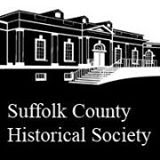 Copyright © 2014 Suffolk County Historical Society.
Copyright © 2014 Suffolk County Historical Society.
—————–
All rights reserved. No part of this document may be reproduced in any form without the written permission of the Suffolk County Historical Society.
www.suffolkcountyhistoricalsociety.org
________________________________________________________________________

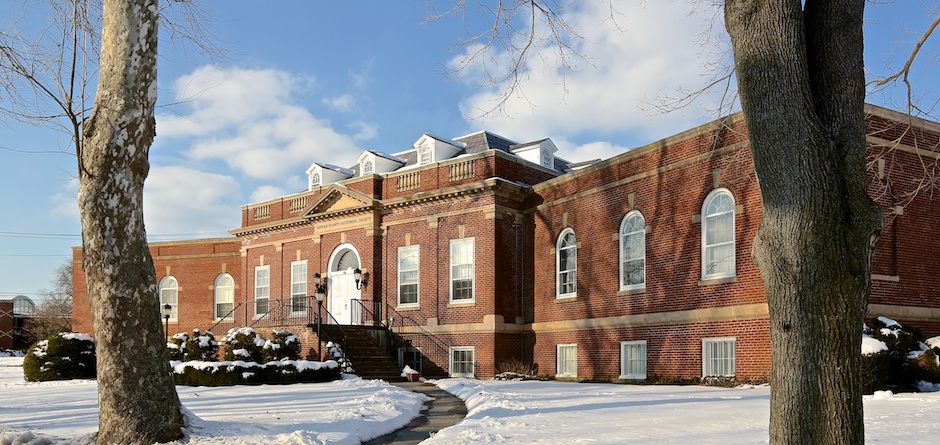
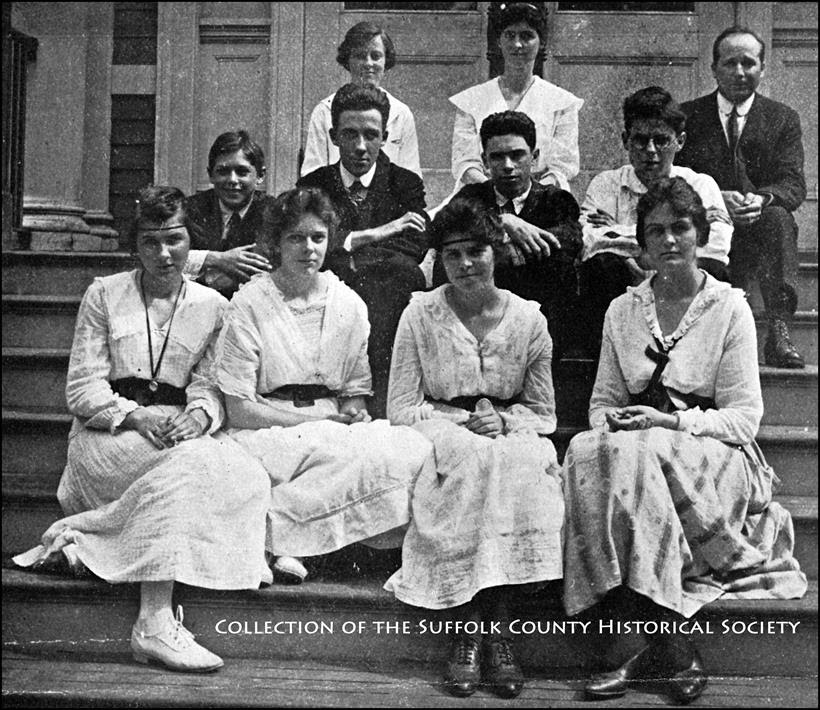

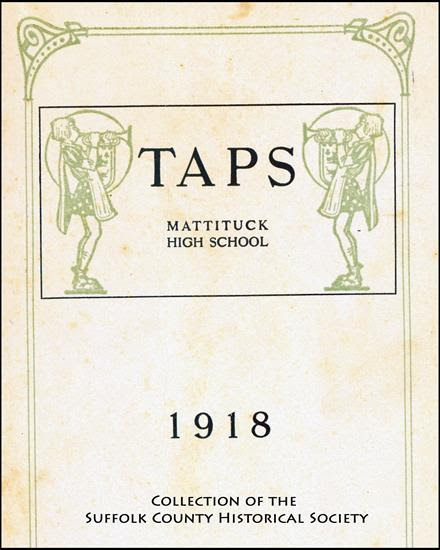


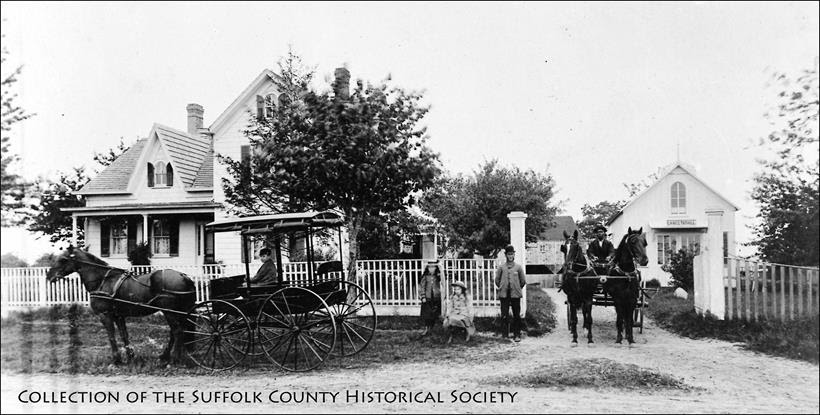
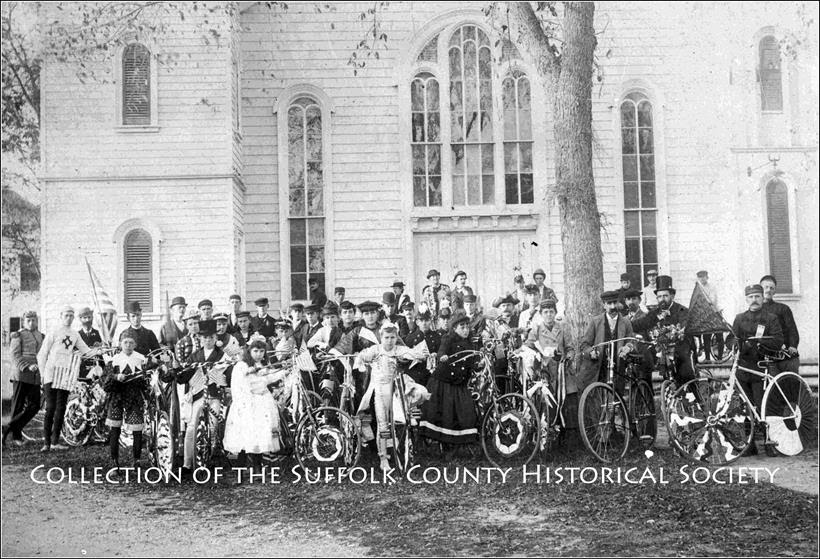
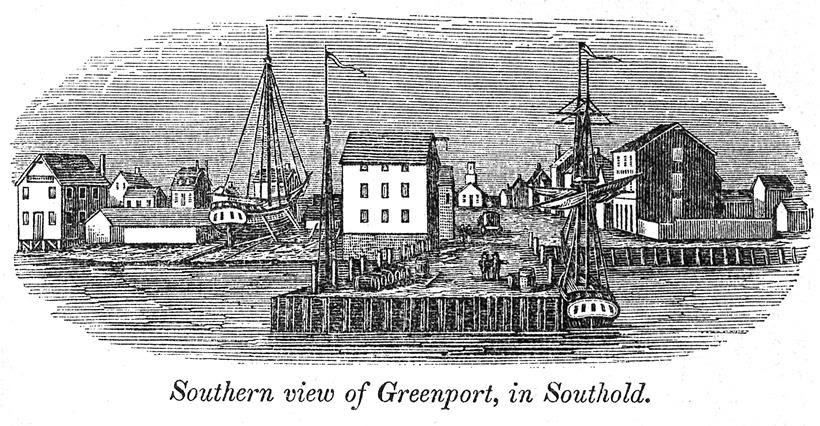



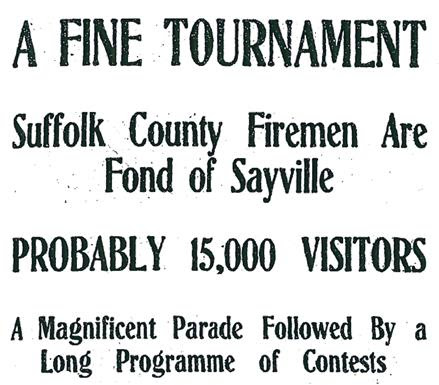

 The Riverhead Woman’s Club, was organized in 1912 and incorporated in 1934. The club joined forces with the NY State Federation of Woman’s Clubs in the 1920s.At one meeting in the 1930s, clubmembers were entertained with a varied program when Mrs. Alice B. Vosburgh of the New York Times Speakers’ Bureau gave an informative talk on the raw materials of the world, especially in America. Mrs. Vosburgh stressed the value of America’s natural wealth and closed her talk with the declaration that “with our great beautiful country, in which there are still many opportunities, there is no need for communism, socialism, fascism, or any other ‘ism’ except Americanism.”
The Riverhead Woman’s Club, was organized in 1912 and incorporated in 1934. The club joined forces with the NY State Federation of Woman’s Clubs in the 1920s.At one meeting in the 1930s, clubmembers were entertained with a varied program when Mrs. Alice B. Vosburgh of the New York Times Speakers’ Bureau gave an informative talk on the raw materials of the world, especially in America. Mrs. Vosburgh stressed the value of America’s natural wealth and closed her talk with the declaration that “with our great beautiful country, in which there are still many opportunities, there is no need for communism, socialism, fascism, or any other ‘ism’ except Americanism.”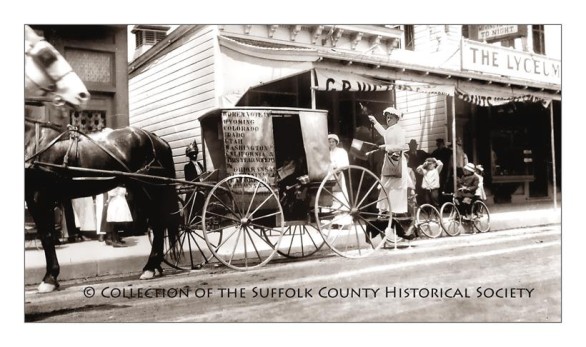 Rosalie Gardiner Jones of Cold Spring Harbor on the Long Island Suffrage Wagon advocating “Votes forTomorrow” (c. 1913).
Rosalie Gardiner Jones of Cold Spring Harbor on the Long Island Suffrage Wagon advocating “Votes forTomorrow” (c. 1913).  This brief article published in The Long Islander on Aug. 8, 1913, states that “Last week was ‘Votes for Women’ week at Central Park and Farmingdale. Miss Rosalie Jones, Miss Irene Danson, and Mrs. Kearns addressed meetings at both places with the result of 14 names in each village being signed in favor of woman suffrage. Miss Jones traveled in her wagon and attracted much attention along the route. She is finishing a 10-day campaign in Nassau County with gratifying results…. The cause of woman suffrage has been greatly advanced in both Nassau and Suffolk counties in the past few months. Clubs have been formed, captains of districts appointed, and the state organization is looking forward to a vigorous campaign….”
This brief article published in The Long Islander on Aug. 8, 1913, states that “Last week was ‘Votes for Women’ week at Central Park and Farmingdale. Miss Rosalie Jones, Miss Irene Danson, and Mrs. Kearns addressed meetings at both places with the result of 14 names in each village being signed in favor of woman suffrage. Miss Jones traveled in her wagon and attracted much attention along the route. She is finishing a 10-day campaign in Nassau County with gratifying results…. The cause of woman suffrage has been greatly advanced in both Nassau and Suffolk counties in the past few months. Clubs have been formed, captains of districts appointed, and the state organization is looking forward to a vigorous campaign….”
